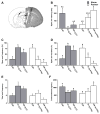Hypothalamic oxytocin mediates social buffering of the stress response
- PMID: 24183103
- PMCID: PMC3969451
- DOI: 10.1016/j.biopsych.2013.09.017
Hypothalamic oxytocin mediates social buffering of the stress response
Abstract
Background: While stressful life events can enhance the risk of mental disorders, positive social interactions can propagate good mental health and normal behavioral routines. Still, the neural systems that promote these benefits are undetermined. Oxytocin is a hormone involved in social behavior and stress; thus, we focus on the impact that social buffering has on the stress response and the governing effects of oxytocin.
Methods: Female prairie voles (Microtus ochrogaster) were exposed to 1 hour immobilization stress and then recovered alone or with their male partner to characterize the effect of social contact on the behavioral, physiological, and neuroendocrine stress response. In addition, we treated immobilized female voles recovering alone with oxytocin or vehicle and female voles recovering with their male partner with a selective oxytocin receptor antagonist or vehicle. Group sizes varied from 6 to 8 voles (N = 98 total).
Results: We found that 1 hour immobilization increased anxiety-like behaviors and circulating levels of corticosterone, a stress hormone, in female prairie voles recovering alone but not the female prairie voles recovering with their male partner. This social buffering by the male partner on biobehavioral responses to stress was accompanied by increased oxytocin release in the paraventricular nucleus of the hypothalamus. Intra-paraventricular nucleus oxytocin injections reduced behavioral and corticosterone responses to immobilization, whereas injections of an oxytocin receptor antagonist blocked the effects of the social buffering.
Conclusions: Together, our data demonstrate that paraventricular nucleus oxytocin mediates the social buffering effects on the stress response and thus may be a target for treatment of stress-related disorders.
Keywords: Corticosterone; HPA axis; elevated plus maze; immobilization stress; pair-bond; social buffering.
Published by Society of Biological Psychiatry on behalf of Society of Biological Psychiatry.
Conflict of interest statement
The authors report no biomedical financial interests or potential conflicts of interest. The authors alone are responsible for the content and writing of the paper.
Figures





Comment in
-
Translational implications of oxytocin-mediated social buffering following immobilization stress in female prairie voles.Biol Psychiatry. 2014 Aug 15;76(4):268-9. doi: 10.1016/j.biopsych.2014.06.017. Biol Psychiatry. 2014. PMID: 25060784 No abstract available.
Similar articles
-
Oxytocin receptor antagonist reverses the blunting effect of pair bonding on fear learning in monogamous prairie voles.Horm Behav. 2020 Apr;120:104685. doi: 10.1016/j.yhbeh.2020.104685. Epub 2020 Jan 24. Horm Behav. 2020. PMID: 31935400 Free PMC article.
-
Anxiety-like behavior and neuropeptide receptor expression in male and female prairie voles: The effects of stress and social buffering.Behav Brain Res. 2018 Apr 16;342:70-78. doi: 10.1016/j.bbr.2018.01.015. Epub 2018 Jan 31. Behav Brain Res. 2018. PMID: 29355675 Free PMC article.
-
Translational implications of oxytocin-mediated social buffering following immobilization stress in female prairie voles.Biol Psychiatry. 2014 Aug 15;76(4):268-9. doi: 10.1016/j.biopsych.2014.06.017. Biol Psychiatry. 2014. PMID: 25060784 No abstract available.
-
Neuropeptidergic regulation of pair-bonding and stress buffering: Lessons from voles.Horm Behav. 2015 Nov;76:91-105. doi: 10.1016/j.yhbeh.2015.08.010. Epub 2015 Sep 1. Horm Behav. 2015. PMID: 26335886 Free PMC article. Review.
-
Sex-specific and social experience-dependent oxytocin-endocannabinoid interactions in the nucleus accumbens: implications for social behaviour.Philos Trans R Soc Lond B Biol Sci. 2022 Aug 29;377(1858):20210057. doi: 10.1098/rstb.2021.0057. Epub 2022 Jul 11. Philos Trans R Soc Lond B Biol Sci. 2022. PMID: 35858094 Free PMC article. Review.
Cited by
-
Amphetamine exposure alters behaviors, and neuronal and neurochemical activation in the brain of female prairie voles.Neuroscience. 2022 Aug 21;498:73-84. doi: 10.1016/j.neuroscience.2022.06.033. Epub 2022 Jul 4. Neuroscience. 2022. PMID: 35798262 Free PMC article.
-
Social Network Plasticity of Mice Parental Behavior.Front Neurosci. 2022 Jun 7;16:882850. doi: 10.3389/fnins.2022.882850. eCollection 2022. Front Neurosci. 2022. PMID: 35747212 Free PMC article. Review.
-
Resting state brain networks in the prairie vole.Sci Rep. 2018 Jan 19;8(1):1231. doi: 10.1038/s41598-017-17610-9. Sci Rep. 2018. PMID: 29352154 Free PMC article.
-
Autism-related behavioral phenotypes in an inbred rat substrain.Behav Brain Res. 2014 Aug 1;269:103-14. doi: 10.1016/j.bbr.2014.04.035. Epub 2014 Apr 26. Behav Brain Res. 2014. PMID: 24780868 Free PMC article.
-
Salivary Oxytocin Is Negatively Associated With Religious Faith in Japanese Non-Abrahamic People.Front Psychol. 2021 Aug 26;12:705781. doi: 10.3389/fpsyg.2021.705781. eCollection 2021. Front Psychol. 2021. PMID: 34512461 Free PMC article.
References
-
- Brown GW. Life events and illness. London: Unwin Hyman; 1989.
-
- Dalgard OS, Dowrick C, Lehtinen V, Vazquez-Barquero JL, Casey P, Wilkinson G, et al. Negative life events, social support and gender difference in depression: A multinational community survey with data from the ODIN study. Soc Psych Psych Epid. 2006;41:444–451. - PubMed
-
- Cohen S, Wills TA. Stress, social support, and the buffering hypothesis. Psychol Bull. 1985;98:310–357. - PubMed
-
- Carter CS, Altemus M. Integrative functions of lactational hormones in social behavior and stress management. Annals of the New York Academy of Sciences: ACTH and Related Peptides: Structure, Regulation, and Action. 1997;807:164–174. - PubMed
Publication types
MeSH terms
Substances
Grants and funding
LinkOut - more resources
Full Text Sources
Other Literature Sources
Medical

